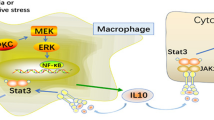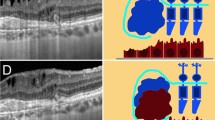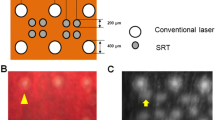Abstract
Purpose
Abnormal fundus autofluorescence (FAF) is associated with the incidence or progression of dry and wet age-related macular degeneration (AMD). We previously developed a rabbit AMD model with drusen and type-1 choroidal neovascularization (CNV) that mimics the accumulation of lipofuscin using artificial glycoxidized particles. The objective of the current study was to investigate in vitro effects of glycoxidized particles on retinal pigment epithelial (RPE) cells, and the FAF and fate of injected particles in this model.
Methods
Glycoxidized particles were prepared by a 4-day incubation of water-in-oil emulsions of serum albumin and glycolaldehyde to allow glycoxidation and consequent cross-linking. After particles were added in the culture medium of confluent human RPE cells, cell viability, adhesion activity, and proliferation activity were assessed by cell counting. In anesthetized rabbits, 250 µg of glycoxidized particles were injected into the subretinal space to induce experimental AMD. FAF measurement and angiography with sodium fluorescein and indocyanine green were performed periodically using the Heidelberg Retina Angiograph 2 (HRA2). The eyes enucleated, and the lung and the spleen, excised at week 4 or 12, were histologically evaluated by light and fluorescence microscopy.
Results
Glycoxidized particles phagocytosed did not impair the cell viability, adhesion, and proliferation of RPE cells, as compared with RPE cells in controls. HRA2 showed different patterns of abnormal FAF in the area with the implanted glycoxidized particles, similar to pathological FAF patterns in aging human eyes with or without AMD. Histologic examination showed accumulated glycoxidized particles and large lipofuscin granules with green autofluorescence in and under the RPE and at the margins of or beneath drusen, possibly associated with abnormal FAF. In addition, some particles were detected in the lung and the spleen.
Conclusions
Glycoxidized particles phagocytosed might stay in RPE cells without any acute biological reaction. Our rabbit model of AMD simulated abnormal FAF patterns observed in aging human eyes with or without AMD. Glycoxidized particles phagocytosed by RPE cells could be deposited on Bruch’s membrane in rabbits, possibly excreted in part into choroidal circulation. This model may be useful for understanding various patterns of abnormal FAF histologically, and for elucidating the pathogenesis of AMD.





Similar content being viewed by others
References
Klein R, Klein BE, Kinton KL (1992) Prevalence of age-related maculopathy. The Beaver Dam Eye Study. Ophthalmology 99:933–943
Klaver CC, Wolfs RC, Vingerling JR, Hofman A, de Jong PT (1998) Age-specific prevalence and causes of blindness and visual impairment in an older population. Arch Ophthalmol 116:653–658
Donoso LA, Kim D, Frost A, Callahan A, Hageman G (2006) The role of inflammation in the pathogenesis of age-related macular degeneration. Surv Ophthalmol 51:137–152, doi:10.1016/j.survophthal.2005.12.001
Evans JR (2001) Risk factors for age-related macular degeneration. Prog Retin Eye Res 20:227–253, doi:10.1016/S1350–9462(00)00023–9
Yin D (1996) Biochemical basis of lipofuscin, ceroid, and age pigment-like fluorophores. Free Radic Biol Med 21:871–888, doi:10.1016/0891–5849(96)00175-X
Okubo A, Rosa RH Jr, Bunce CV, Alexander RA, Fan JT, Bird AC, Luthert PJ (1999) The relationships of age changes in retinal pigment epithelium and Bruch’s membrane. Invest Ophthalmol Vis Sci 40:443–449
Schutt F, Bergmann M, Holz FG, Kopitz J (2003) Proteins modified by malondialdehyde, 4-hydroxynonenal, or advanced glycation end products in lipofuscin of human retinal pigment epithelium. Invest Ophthalmol Vis Sci 44:3663–3668, doi:10.1167/iovs.03–0172
Moore DJ, Hussain AA, Marshall J (1995) Age-related variation in the hydraulic conductivity of Bruch’s membrane. Invest Ophthalmol Vis Sci 36:1290–1297
Haralampus-Grynaviski NM, Lamb LE, Clancy CM, Skumatz C, Burke JM, Sarna T, Simon JD (2003) Spectroscopic and morphological studies of human retinal lipofuscin granules. Proc Natl Acad Sci U S A 100:3179–3184, doi:10.1073/pnas.0630280100
Ng KP, Gugiu B, Renganathan K, Davies MW, Gu X, Crabb JS, Kim SR, Rózanowska MB, Bonilha VL, Rayborn ME, Salomon RG, Sparrow JR, Boulton ME, Hollyfield JG, Crabb JW (2008) Retinal pigment epithelium lipofuscin proteomics. Mol Cell Proteomics 7:1397–1405, doi:10.1074/mcp.M700525-MCP200
Schmitz-Valckenberg S, Bindewald-Wittich A, Dolar-Szczasny J, Dreyhaupt J, Wolf S, Scholl HP, Holz FG (2006) Correlation between the area of increased autofluorescence surrounding geographic atrophy and disease progression in patients with AMD. Invest Ophthalmol Vis Sci 47:2648–2654, doi:10.1167/iovs.05–0892
Bindewald A, Schmitz-Valckenberg S, Jorzik JJ, Dolar-Szczasny J, Sieber H, Heilhauer C, Weinberger AW, Dithmar S, Pauleikhoff D, Mansmann U, Wolf S, Holz FG (2005) Classification of abnormal fundus autofluorescence patterns in the junctional zone of geographic atrophy in patients with age related macular degeneration. Br J Ophthalmol 89:874–878, doi:10.1136/bjo.2004.057794
Bindewald A, Bird AC, Dandekar SS, Dolar-Szczasny J, Dreyhaupt J, Fitzke FW, Einbock W, Holz FG, Jorzik JJ, Keilhauer C, Lois N, Mlynski J, Pauleikhoff D, Staurenghi G, Wolf S (2005) Classification of fundus autofluorescence patterns in early age-related macular disease. Invest Ophthalmol Vis Sci 46:3309–3314, doi:10.1167/iovs.04–0430
Schmitz-Valckenberg S, Holz FG, Bird AC, Spaide RF (2008) Fundus autofluorescence imaging. Review and perspectives. Retina 28:385–409
Yasukawa T, Wiedemann P, Hoffmann S, Kacza J, Eichler W, Wang YS, Nishiwaki A, Seeger J, Ogura Y (2007) Glycoxidized particles mimic lipofuscin accumulation in aging eyes: a new age-related macular degeneration model in rabbits. Graefes Arch Clin Exp Ophthalmol 245:1475–1485, doi:10.1007/s00417–007–0571-z
Akasaka Y, Ueda H, Takayama K, Machida Y, Nagai T (1988) Preparation and evaluation of bovine serum albumin nanospheres coated with monoclonal antibodies. Drug Des Deliv 3:85–97
Ryan SJ (1982) Subretinal neovascularization: natural history of an experimental model. Arch Ophthalmol 100:1804–1809
Dobi ET, Puliafito CA, Destro M (1989) A new model of choroidal neovascularization in the rat. Arch Ophthalmol 107:264–269
Kimura H, Sakamoto T, Hinton DR, Spee C, Ogura Y, Tabata Y, Ikada Y, Ryan SJ (1995) A new model of subretinal neovascularization in the rabbit. Invest Ophthalmol Vis Sci 36:2110–2119
Cui JZ, Kimura H, Spee C, Thumann G, Hinton DR, Ryan SJ (2000) Natural history of choroidal neovascularization induced by vascular endothelial growth factor in the primate. Graefes Arch Clin Exp Ophthalmol 238:326–333, doi:10.1007/s004170050360
Pollack A, Korte GE, Weitzner AL, Henkind P (1986) Ultrastructure of Bruch’s membrane after krypton laser photocoagulation. Arch Ophthalmol 104:1372–1376
Pollack A, Korte GE, Heriot WJ, Henkind P (1986) Ultrastructure of Bruch’s membrane after krypton laser photocoagulation. II. Repair of Bruch’s membrane and the role of macrophages. Arch Ophthalmol 104:1377–1382
Baffi J, Byrnes G, Chan CC, Csaky KG (2000) Choroidal neovascularization in the rat induced by adenovirus mediated expression of vascular endothelial growth factor. Invest Ophthalmol Vis Sci 41:3582–3589
Spilsbury K, Garrett KL, Shen WY, Constable IJ, Rakoczy PE (2000) Overexpression of vascular endothelial growth factor (VEGF) in the retinal pigment epithelium leads to the development of choroidal neovascularization. Am J Pathol 157:135–144
Handa JT, Verzijl N, Matsunaga H, Aotaki-Keen A, Lutty GA, te Koppere JM, Miyata T, Hjelmeland LM (1999) Increase in the advanced glycation end product pentosidine in Bruch’s membrane with age. Invest Ophthalmol Vis Sci 40:775–779
Vitek MP, Bhattacharya K, Glendening JM, Stopa E, Vlassara H, Bucala R, Manoque K, Cerami A (1994) Advanced glycation end products contribute to amyloidosis in Alzheimer disease. Proc Natl Acad Sci U S A 91:4766–4770, doi:10.1073/pnas.91.11.4766
Vlassara H (1996) Advanced glycation end-products and atherosclerosis. Ann Med 28:419–426, doi:10.3109/07853899608999102
Matsumoto K, Ikeda K, Horiuchi S, Zhao H, Abraham EC (1997) Immunochemical evidence for increased formation of advanced glycation end products and inhibition by aminoguanidine in diabetic rat lenses. Biochem Biophys Res Commun 241:352–354, doi:10.1006/bbrc.1997.7744
Bierhaus A, Hofmann MA, Ziegler R, Nawroth PP (1998) AGEs and their interaction with AGE-receptors in vascular disease and diabetes mellitus. I. The AGE concept. Cardiovasc Res 37:586–600, doi:10.1016/S0008–6363(97)00233–2
Ishibashi T, Murata T, Hangai M, Nagai R, Horiuchi S, Lopez PF, Hinton DR, Ryan SJ (1998) Advanced glycation end products in age-related macular degeneration. Arch Ophthalmol 116:1629–1632
Acharya AS, Manning JM (1983) Reaction of glycolaldehyde with proteins: Latent crosslinking potential of a-hydroxyaldehydes. Proc Natl Acad Sci USA 80:3590–3594, doi:10.1073/pnas.80.12.3590
Schmitz-Valckenberg S, Holz FG, Bird AC, Spaide RF (2008) Fundus autofluorescence imaging. Review and Perspectives. Retina 28:385–409
Kamei M, Yoneda K, Kume N, Suzuki M, Itabe H, Matsuda K, Shimaoka T, Minami M, Yonehara S, Kita T, Kinoshita S (2007) Scavenger receptors for oxidized lipoprotein in age-related macular degeneration. Invest Ophthalmol Vis Sci 48:1801–1807, doi:10.1167/iovs.06–0699
Yamada Y, Ishibashi K, Ishibashi K, Bhutto IA, Tian J, Lutty GA, Handa JT (2006) The expression of advanced glycation endproduct receptors in rpe cells associated with basal deposits in human maculas. Exp Eye Res 82:840–848, doi:10.1016/j.exer.2005.10.005
Guymer R, Luthert P, Bird A (1999) Changes in Bruch’s membrane and related structures with age. Prog Retin Eye Res 18:59–90, doi:10.1016/S1350–9462(98)00012–3
Yamamoto T, Fukuda S, Obata H, Yamashita H (1994) Electron microscopic observation of pseudopodia from choriocapillary endothelium. Jpn J Ophthalmol 38:129–138
Lengyel I, Tufail A, Hosaini HA, Luthert P, Bird AC, Jeffery G (2004) Association of drusen deposition with choroidal intercapillary pillars in the aging human eye. Invest Ophthalmol Vis Sci 45:2886–2892, doi:10.1167/iovs.03–1083
Acknowledgements
Tsutomu Yasukawa, MD, PhD, conducted the current study as an Alexander von Humboldt Foundation scholar. We thank Grit Müller for help with animal surgery and Ute Weinbrecht, Karin Bartholomäus, and Silke Jantzen for technical assistance.
Author information
Authors and Affiliations
Corresponding author
Additional information
Supported in part by German Research Community (DFG) grant WI 880/9–1 and by a 2006 Grant-in-Aid for Scientific Research No. 18591929 from Japan Society for the Promotion of Science.
Rights and permissions
About this article
Cite this article
Hirata, M., Yasukawa, T., Wiedemann, P. et al. Fundus autofluorescence and fate of glycoxidized particles injected into subretinal space in rabbit age-related macular degeneration model. Graefes Arch Clin Exp Ophthalmol 247, 929–937 (2009). https://doi.org/10.1007/s00417-009-1070-1
Received:
Revised:
Accepted:
Published:
Issue Date:
DOI: https://doi.org/10.1007/s00417-009-1070-1




